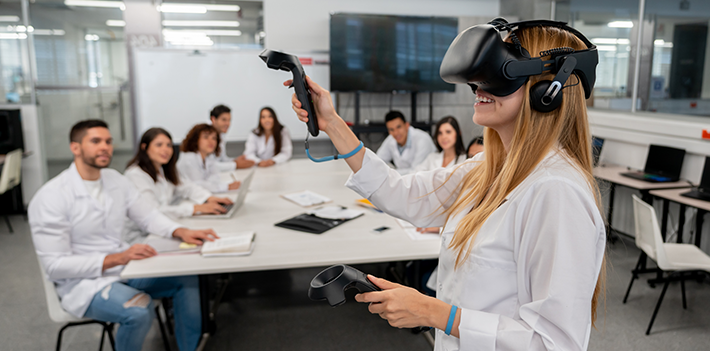What’s stopping innovation in higher education?

Students expect a flexible and personalised approach to course delivery. They want education on demand, which mirrors how they use tech and consume content in their social life.

What if students of all ages - whoever and wherever they are, and whatever their background - could learn flexibly around work and family commitments and across time zones? If they could move fluidly across physical, digital and social experiences – and these were all highly engaging and interactive?
What if mixed reality technologies and artificial intelligence (AI) were seamlessly integrated into the learning experience so it effortlessly melds the needs and preferences of the individual learner?
What if all staff felt supported to enhance their digital skills and all leaders were fluent in technology-enhanced learning and excited to adapt their offering to reach a wider range of markets, expanding smoothly beyond their physical bases into the virtual world and so into the wider geographic world?
This is not a pipe dream, but there are barriers to this becoming reality.
What does the future look like?
Together, we can reimagine the future and set a new agenda that accelerates progress.
In learning and teaching, AI is already being used to help students develop essential soft skills such as collaboration, problem solving and critical thinking. Chatbots are saving staff time at Keele and Leeds Beckett universities during the always frantic clearing period by giving prospective students instant answers to their questions.
Data analytics is widely used to better understand student engagement, improve teaching and the overall student experience.
Immersive technologies – virtual reality (VR) and augmented reality (AR) – can transform simulation and practice, offering realistic, cost-effective, convenient and, in some cases, safer ways to learn.
Looking ahead, sentiment analysis built ethically into interactive classrooms and video conferencing software could help show how learners are engaging. It could map engagement to tutor behaviours, such as body language, movement around the classroom, and tone of voice, to provide feedback on how to improve.
Immersive technologies – virtual reality (VR) and augmented reality (AR) – can transform simulation and practice, offering realistic, cost-effective, convenient and, in some cases, safer ways to learn.
For example, the University of Leeds is providing student doctors with a front row seat in the operating theatre with its VR training programme, while dental trainees can practise on virtual cases using simulated handheld instruments which recreate the sense of touch.
Cloud technology is enabling the use of AI, machine learning, text analysis and image recognition that change the way science is done
In research, advanced technologies such as AI, robotics, 5G, quantum computing and biotechnologies are set to impact the UK’s world-leading research and innovation sector in ways yet to be imagined.
Cloud technology is enabling the use of AI, machine learning, text analysis and image recognition that change the way science is done. Big data and cloud computing tools are revolutionising the way vaccines are being developed.
What are the barriers?
UK HE has under-invested in digital for years because it’s not seen as a strategic advantage. In the bricks versus clicks contest, investment in technology has lagged. The past decade has seen the expansion of the campus university, with institutions spending billions on buildings but only millions on their digital equivalents.
Risk aversion is often the culprit. If IT is perceived as a source of risk — of data loss or security incidents, of system failure or subpar user experience, indeed as a risk to the university model itself — there is little incentive to invest.
But, as the last two years have made clear, universities cannot risk under-investing in technology. This is where leaders need to step up.
A coherent strategic approach to digital can help address many of the major existential risks the sector faces, mitigating rather than creating them. To achieve this, university strategies must adopt a longer-term view on the role of digital technology.
Staff training
A lack of investment in technology is only part of the problem; there are other obstacles.
We expect teaching staff to embrace blended learning, but they need time and support to develop digital competence and confidence.
Sadly, the latest Jisc digital experience insights report shows that only 38% of institutions provide guidance to staff about the digital skills required in their role. Only 14% of staff said they had training in creating digital learning material, 7% in digital copyright, and 5% in social media management.
Reward, recognition and performance management are part of this and will go a long way to supporting and motivating staff. Yet, the survey showed that only 16% of staff received rewards or recognition for the digital skills they developed.
We need to trust staff with time and space to experiment and learn how to enhance their teaching, using new, digital approaches
To help staff develop, we may need to change recognition frameworks, with formal evaluations linked to goals around developing digital competencies and culture. Expanding employees' learning abilities will enable them to feel more digitally empowered.
We need to trust staff with time and space to experiment and learn how to enhance their teaching, using new, digital approaches. Staff who are inspired and encouraged to explore and innovate will learn from successes and, more importantly, failures. They will help to introduce new ideas and ways of working across the whole organisation.
Leadership
Finally, and crucially, leadership is needed. Leadership in digital transformation is one of the top three digital priorities for higher and further education, as highlighted in our 2022 teaching staff digital experience insights survey.
All too often, digital solutions within universities are introduced on an ad-hoc basis, with insufficient support, ending up at best a bonus and sometimes a source of frustration.
Leaders must set strategic direction and promote digital-first thinking by inspiring others to consider different choices. Leaders need to make it their business to keep up to date with technological advances and to lead by example.
It can be done – together
HE can innovate and move at pace – as was proved in response to the pandemic. Using the building blocks already in place, the sector was able to move quickly.
To build on that shift, digital needs to be recognised as a strategic asset and a way to help deliver the university’s mission.
The coming decade calls for a radical change in mindset around digital – and risk. Senior leaders must take a clear view on areas in which they are prepared to experiment and, potentially, fail: actively pursue new initiatives and openly working with startup technology providers.
There may also be opportunities for greater risk-sharing and collaboration across both higher and further education in the UK.
Experimentation is costly in terms of time, energy and outcome, meaning that there is real scope for networks that experiment collectively across several subject areas. This can help the sector move towards joint services, shared services and joint investment into digital technology, as well as cost-sharing around software.
Jisc can help. For example, a strategic and operational priority for us is to offer members more managed services in areas such as network, cloud, infrastructure and security. We already provide a number of them, including AWS, Azure and Microsoft 365.
The foundations are laid. The support is in place. There’s nothing to stop us.
- Heidi Fraser-Krauss is speaking at Bett UK, on 24 March.
About the author

I joined Jisc as chief executive officer in September 2021. My key priority is to ensure Jisc stays innovative and focused on the needs of students, educators and researchers in what will be a turbulent but, I am sure, productive time ahead.